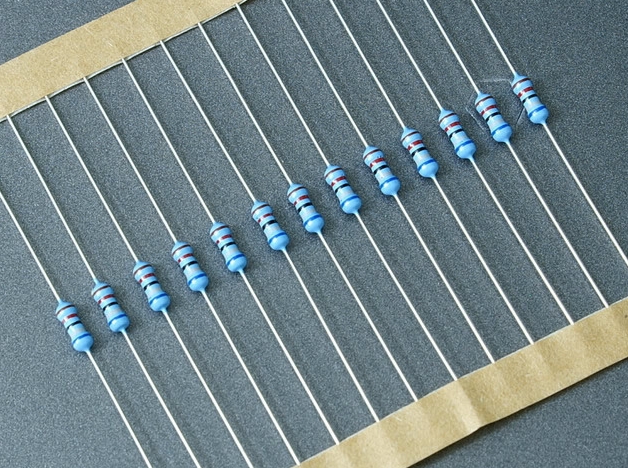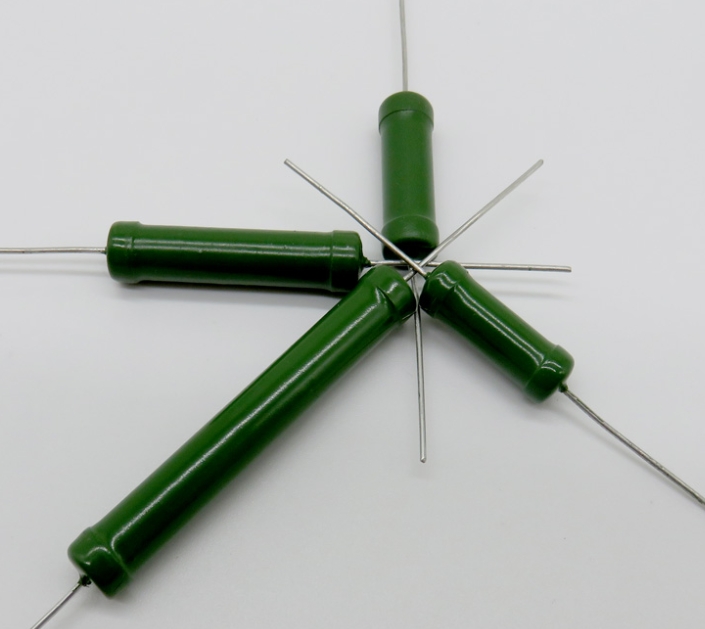Table of Contents
What is a resistor?
A resistor (Resistor) is an electronic component used to limit current, usually made of conductive materials such as carbon film, metal film, or alloy wire. It plays the role of voltage division, current division, and current limiting in circuits, and is one of the core passive devices in electronics. A resistor creates resistance by impeding the flow of current, thus realizing the control of voltage and current in a circuit. Its resistance value is defined by Ohm’s law:

Where R is the resistance value, V is the voltage and I is the current.
PHYSICAL CHARACTERISTICS: The main physical characteristic of a resistor is that it converts electrical energy into thermal energy, hence it is also known as an energy-consuming element.
Resistance units are ohms (Ω), kilohms (kΩ), megohms (MΩ), terohms (TΩ).
What are the Resistors
- Classification by Material
Carbon Film Resistors: low cost, stable performance, a wide range of resistance values, widely used in general electronic products.
Metal film resistors: high precision, good stability, low noise, suitable for precision instruments and communication equipment.
Metal Oxide Film Resistors: Good heat resistance, high chemical stability, suitable for high temperature environment.
Wirewound Resistors: High power, high precision, but poor high-frequency performance, commonly used in high-power circuits and precision measurements.
Vitreous enamel resistors: high temperature and humidity resistant, suitable for harsh environments. - Classified by Function
Fixed Resistors: Fixed resistance value, commonly used in various circuits.
Variable Resistors (Potentiometers): Adjustable resistance value, used to adjust the voltage or current in the circuit.
Sensitive resistors: resistance value changes with the external environment (such as temperature, light, pressure, etc.), including thermistors, photosensitive resistors, varistors, and so on. - Categorized by purpose
Current Limiting Resistors: Used to limit the amount of current in a circuit.
Voltage divider resistors: used to distribute voltage to different parts of the circuit.
Protective Resistors: Used to protect circuits from over-current or over-voltage damage.
Decoupling Resistors: Used to reduce noise and interference in a circuit. - Categorized by structure
Chip Resistors: Small size, suitable for high-density circuit boards.
Row Resistors: Multiple resistors integrated, commonly used in integrated circuits.
Cement Resistors: High power, low resistance value, good flame retardant, and explosion-proof characteristics. - Specialty Resistors
Fuse Resistors: Combining the functions of a resistor and a fuse, these resistors will fuse when the circuit is overloaded to protect the circuit.
Sensitive Resistors: such as thermistors, photosensitive resistors, etc., are used for detecting and controlling environmental parameters.
How Resistors Work

The basic principle of how resistors work is Ohm’s Law, or V=IR, which means that the voltage (V) is equal to the product of the current (I) and the resistance (R). This means that the higher the resistance, the lower the current through it. Resistors utilize this principle to limit the amount of current by increasing the resistance in a circuit, thus preventing excessive current from damaging circuit components.
The main parameters of a resistor are resistance value and power. The resistance value determines how much the resistor blocks the current, while the power indicates the maximum power that the resistor can withstand. When selecting a resistor, we need to choose the appropriate resistance value and power according to the actual demand to ensure that the resistor can work properly in the circuit.
Positive and Negative Connection Methods for Resistors
Resistors do not have a clear distinction between positive and negative poles, unlike devices such as batteries or diodes. In a circuit, resistors can conduct current bi-directionally. However, there are still certain rules and precautions to follow when connecting resistors.
Series Connection: In a circuit, resistors are often connected in series. When connected in series, current passes through each resistor in turn. It should be noted that the current is the same throughout the circuit, while the voltage drop across each resistor varies according to its resistance value.
Parallel Connection: Resistors can also be connected in parallel in a circuit. When connected in parallel, the ends of each resistor are connected directly to two nodes of the circuit. This allows current to flow through each resistor separately, and the amount of current on each resistor will vary depending on its resistance value.
When connecting the resistors, it is important to make sure that they are firmly connected and have good contact to avoid poor contact or short circuits. In addition, it is also important to choose the appropriate connection method in conjunction with the actual circuit requirements and the parameters of the resistors to achieve the best circuit results.
What is the role of resistors?

Resistors are indispensable basic components of electronic circuits, and their main roles include limiting current, voltage division, shunt, regulating voltage, and protecting circuits.
- Limiting Current
Resistors can effectively limit the amount of current in a circuit by impeding the flow of current. According to Ohm’s law (I = V / R), increasing the value of the resistor can reduce the current in the circuit, thereby preventing damage to components due to overcurrent. For example, in an LED circuit, connecting a resistor in series can limit the current within the rated operating range of the LED to ensure its proper operation. - Voltage Sharing
In a series circuit, a resistor can distribute the voltage according to the proportion of the resistance value and play the role of voltage sharing. Through a reasonable choice of resistance value, you can get a specific voltage signal from the supply voltage. This voltage divider function is commonly used in voltage detection, reference circuits, and voltage protection scenarios. - Shunt
In parallel circuits, the resistor can divert the excess current to ensure that the voltage does not change. The shunt function is often used in complex circuits to provide the proper current for multiple branches. - Voltage Regulation
Used with variable circuits such as potentiometers, resistors can adjust the output voltage or current magnitude. This adjustment function is widely used in the fields of power management and signal processing. - Protecting Circuits
Resistors can be used as safety resistors or current limiting elements to prevent other sensitive components from being damaged by sudden current changes. For example, in the base circuit of a triode, a current-limiting resistor prevents the base current from being too high and causing the triode to saturate. - Other Functions
Energy Conversion: When current passes through a resistor, it converts part of the electrical energy into heat energy, and this principle is applied to devices such as electric water heaters and electric stoves.
Matching Impedance: In electronic circuits, resistors are used for impedance matching between different modules to ensure the stability of signal transmission.
Pull-Up/Pull-Down Resistors: In digital circuits, pull-up, and pull-down resistors are used to clamp uncertain signals at a high or low level to avoid uncertain circuit states.
Applications of Resistors

Voltage and Current Sharing: Resistors are often used in circuits to share voltage and current to control the distribution of voltage and current.
Current Limiting Protection: By limiting the amount of current, resistors can protect other components in a circuit from overload damage.
Signal Processing: Resistors are effective for both AC and DC signals and are widely used in signal-processing circuits.
To summarize
Resistors play diverse and critical roles in circuits, ranging from limiting current to dividing voltage and current, to protecting circuits and regulating voltage, and their functions cover all aspects of electronic devices. Proper selection and use of resistors can ensure the stability and reliability of the circuit.
